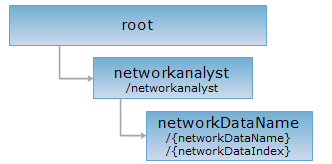
<networkanalyst_uri>/{networkdataName}[.<format>]
<networkanalyst_uri>/{networkdataIndex}[.<format>]
closestfacility, connectedEdges, edgeWeight, location, model, MTSPPath, path, serviceArea, traceDown, traceUp, TSPPath, turnNodeWeight, weightMatrix, burstAnalyse, upstreamcirticalfaclilities, downstreamcirticalfaclilities
The networkDataName resource represents a network dataset that can be used in transportation analysis. Performing a GET request on {networkDataName} or {networkdataIndex} resource can get the description information of the network dataset, like projection information, turning weight field name, weight name and all the transportation analyst functionality supported.
Supported Methods:
Supported output formats: rjson, json, html, xml, jsonp.

Below is an example of performing an HTTP request on a URI with rjson as the output format. supermapiserver in the URI is the name of the server, and RoadNet@Changchun is the name of the network dataset.
http://supermapiserver:8090/iserver/services/transportationanalyst-sample/rest/networkanalyst/RoadNet@Changchun.rjson
Gets all the transportation analysis functions supported by the network dataset.
None.
After a GET request is performed on the networkDataName resource, the entity body of the response message contains a set of descriptions of the transportation analysis functions. Each description has the following structure:
| Field | Type | Description |
| weightNames | String[] | The weight names. |
| turnWeightFieldNames | String[] | The field names of the turn weights. |
| prj | PrjCoordSys | The projection information of the network dataset. |
By executing a GET request on networkDataName resource, the returned response result in rjosn format is as follows:
{
"prj": {
"coordSystem": null,
"coordUnit": "METER",
"distanceUnit": "METER",
"epsgCode": -1000,
"name": "Planar Coordinate System---m",
"projection": null,
"projectionParam": null,
"type": "PCS_NON_EARTH"
},
"turnWeightFieldNames": ["TurnCost"],
"weightNames": [
"length",
"time"
]
}
Returns the same HTTP response header as the GET request, but no response entity, which can be used to retrieve the meta data contained in response message header without having to transmit the entire response content. Meta data information includes media type, character coding, compression coding, entity content length, etc.
HEAD request is used to determine whether the networkDataName resource exists, or if the user has the authority to access it. By executing an HEAD request with a .<format> URI, you can quickly determine whether the networkDataName resource supports the <format> representation.